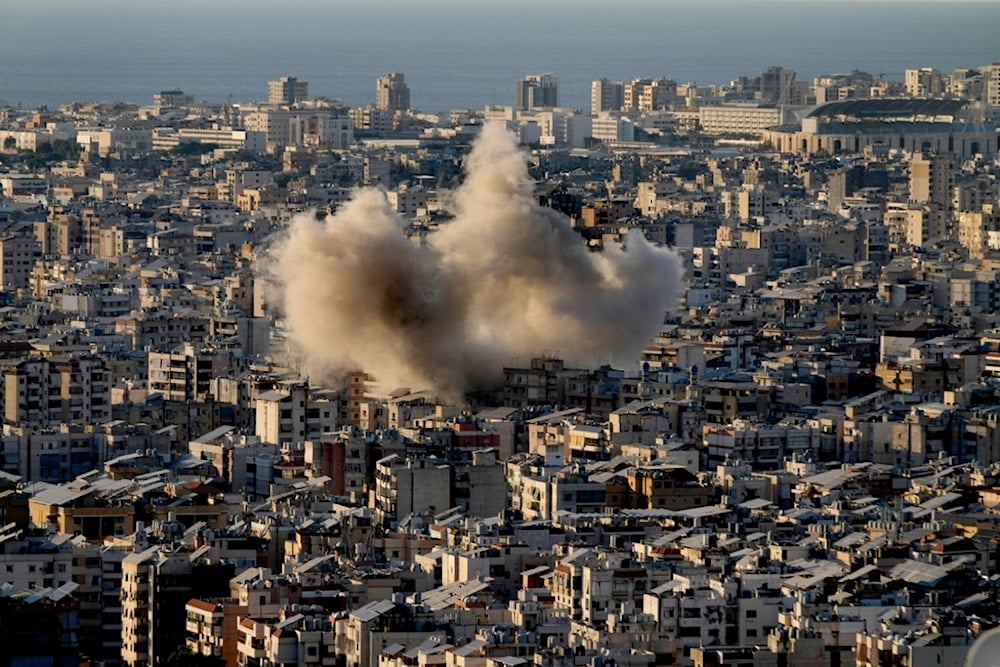'Israel' renews airstrikes on Beirut Southern Suburb, untouched areas
The Israeli occupation's airstrikes on the Southern Suburb of Beirut while also attacking previously untouched areas.
-

Smoke rises from Israeli airstrikes on Dahieh, the southern suburb of Beirut, Lebanon, Saturday, October 19, 2024. (AP)
Israeli drones and fighter jets launched on Saturday more than 11 consecutive airstrikes targeting the Lebanese capital of Beirut's southern suburb and surrounding areas. The strikes hit residential buildings in the neighborhoods of Haret Hreik, Burj al-Barajneh, and Choueifat, leveling them to the ground, an Al Mayadeen correspondent reported.
Thick plumes of smoke rose from the targeted areas following the blasts, as fires and destruction swept through them.
Earlier in the day, two civilians—a man and a woman—were killed when an Israeli drone targeted their vehicle on the Jounieh highway, north of the capital, heading toward Beirut, the Lebanese Ministry of Health reported.
Traffic authorities confirmed that the strike caused the road to be blocked for traffic on the western lane of the coastal highway in Sahel Alma.
In the Bekaa Valley, Israeli forces carried out several attacks, the most significant of which hit the town of Baaloul in western Bekaa. The attack resulted in the martyrdom of five individuals, including the mayor of Sohmpr, Haidar Shahla, and left around 10 others wounded, according to the Ministry.
Additionally, the National News Agency reported that the Israeli occupation bombed a building in the al-Asira neighborhood of Baalbek. Ambulances rushed to the scene, and search operations continued for those trapped under the rubble.
The Israeli occupation forces also launched airstrikes on the town of Ansar in the Baalbek district.
In southern Lebanon, several villages were hit by Israeli airstrikes, including Qabreikha, an open area between the towns of Sarafand and Baysariyyeh, as well as the towns of Tireh, Joumeijmeh, Deir Qanoun-Ras al-Ain, Jabal al-Batm, Byout al-Siyad, Yater, Zebqine, Aita al-Shaab, Marwahin, Ramieh, Beit Lif, and Taybeh.
In the afternoon, the Israeli occupation forces also bombed the city of Bint Jbeil, while artillery shelling with phosphorus munition ignited fires in the forests surrounding Kfar Chouba.
Earlier today, Israeli forces also struck a residential building in the town of Anqoun in southern Lebanon.
The death toll from Israeli attacks on Lebanon has risen to 2,367, with more than 11,000 wounded.
US complicity in bombardment
The Guardian reported on Saturday having found the tail fin of a Joint Direct Attack Munition (JDAM), a guidance system that converts conventional bombs into precision-guided weapons, among the rubble in Nabatiyeh, southern Lebanon. The munition, confirmed by Human Rights Watch's crisis, conflict, and arms division, was one of many used in the Israeli aggression on Lebanon. A similar device was found in a previous airstrike that killed 22 people in Beirut.
Previously, The Guardian had reported that a US-made munition was used in the strike in central Beirut on Thursday in a failed attempt to assassinate Wafiq Safa, head of Hezbollah's Coordination and Liaison Unit.
According to the Lebanese Ministry of Health, the aggression led to the martyrdom of 22 people and the injury of 117 others. First responders on the scene said that rescue teams had been searching under the debris all night for survivors and martyrs, adding that since residents recently welcomed evacuated Lebanese due to Israeli aggression in other regions, the building had more occupants than usual, making it the bloodiest attack in a year.
The Guardian discovered pieces of a JDAM made in the US in the wreckage of the fallen apartment building. The US aerospace business Boeing manufactures JDAMs, which are guidance kits that connect to big "dumb bombs" weighing up to 2,000 pounds (900 kg) and turn them into GPS-guided bombs.
The weapons residue was confirmed by a veteran US military bomb technician and Human Rights Watch's crisis, conflict, and armaments section.
After seeing a photograph of the fragment, Richard Weir, a senior researcher in Human Rights Watch’s crisis, conflict, and arms division explained that the “bolt pattern, its position and the shape of the of the remnant are consistent with the tail fin of a US-made, JDAM guidance kit for Mk80 series air-dropped munitions."

 4 Min Read
4 Min Read








